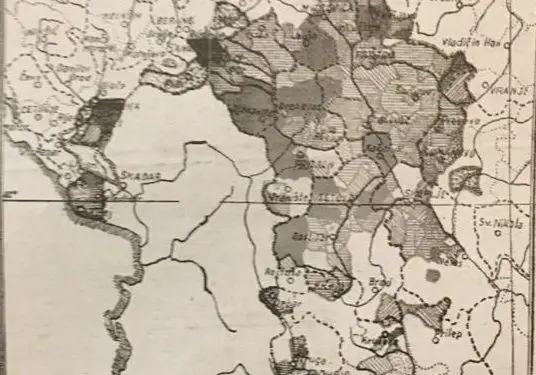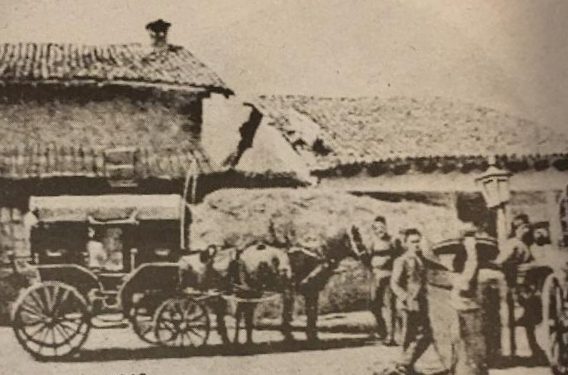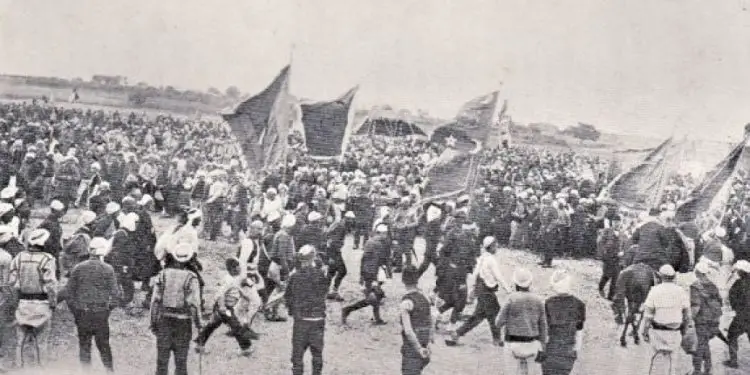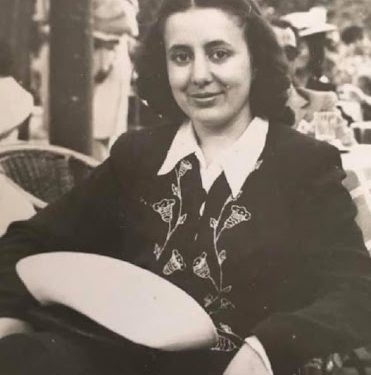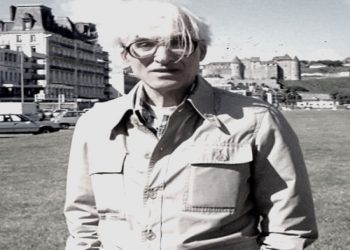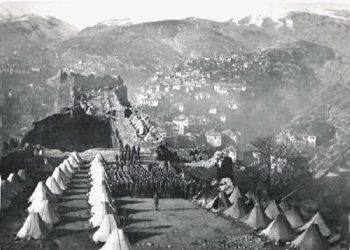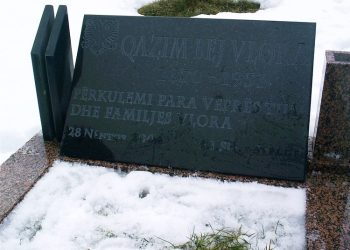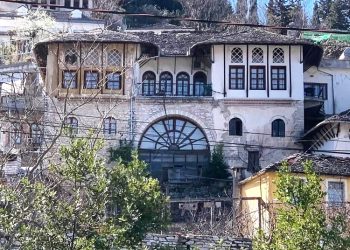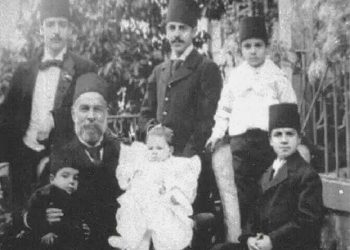Dashnor Kaloçi
Memorie.al publishes the unknown story of the book “Kosovo, the cradle of Albanianism” by the well-known intellectual, Hamit Kokalari, which was published in 1943 and was received with great interest, not only in the intellectual circles of Tirana but also in all Albanian territories where it was immediately disbanded. Kokalari was the suckling of one of the most famous and nationalist families in the city of Gjirokastra, who only a short time ago had served as a senior official in the local administration of Kosovo. The book in question had only 125 pages and consisted of about 27 chapters, where the author has used hundreds of references of Albanian authors, such as Fan Noli, Mit’hat Frashëri, Dom Luigj Gashi, Zef Fekeçi, Karl Gurakuqi, Xhaferr Belegu, etc. as well as foreigners such as Antonio Baldaçi, Angelo Pernice, Edit Durham, Milan Shuflai, Justin Godard, Bernard Newman, etc. Many of the study chapters of Kokalari are illustrated with special tables, which present data on the population of the Albanian territories occupied by the Slavs, as well as various maps published by well-known academics and institutes in Europe. The book in question was republished in 1961 in Italy by a group of Albanian nationalist intellectuals with a foreword by prof. Abaz Ermenji, while in Albania he never saw the light of publication, even though the author wrote a letter to Nexhmije Hoxha, from which he received a negative answer… ?! From that time onwards and in the years that followed, in order to secure a living, Hamiti dealt with various translations, as he excelled in five or six foreign languages and did not suffer from a long illness. He passed away in 1989. , while his two brothers, Muntazi and Vesimi, had been shot since 1944 by order of Enver Hoxha, and his sister, the famous intellectual Musine Kokalari, had passed away in 1984 in the city of Rrëshen, after many years in prison. of internment.
It was not until the beginning of 1943, when more than two or three years had passed since fascist Italy had recognized ethnic Albania, and returned to it almost all the Albanian territories, that the Congress of Berlin in 1878, as well as the London Conference. in 1913, they had unjustly separated her from her neighbors in the Albanian capital, Tirana, and a book entitled “Kosovo, the Cradle of Albanianism” was published. The author of this famous book that was received with extraordinary interest, not only in the intellectual circles of Tirana but also in all Albanian territories where it was immediately distributed, was a young intellectual, named Hamit Kokalari. He was the suckling of one of the most famous and nationalist families of the city of Gjirokastra, who only a short time ago had served as a senior official in the local administration of Kosovo. The book in question had only 125 pages and consisted of about 27 chapters, where the author has used hundreds of references of Albanian authors, such as Fan Noli, Mit’hat Frashëri, Dom Luigj Gashi, Zef Fekeçi, Karl Gurakuqi, Xhaferr Belegu, etc. as well as foreigners such as Antonio Baldaçi, Angelo Pernice, Edit Durham, Milan Shuflai, Justin Godard, Bernard Newman, etc. Many of the study chapters of Kokalari are illustrated with special tables, which present data on the population of the Albanian territories occupied by the Slavs, as well as various maps published by well-known academics and institutes in Europe. In addition to numerous references and archival documents with which he consulted, the author of the book in the preface has given special thanks to the great help he had given, Reuf Fico, one of the most famous Albanian politicians and diplomats of the half of first of the last century, who in the last years of his career, served as ambassador of the Albanian Kingdom of Zog, in Belgrade. From Kokalari’s book, “Kosovo, the cradle of Albanians”, we have selected and are publishing in the original version and without any changes, only some parts of it, thinking that even more light is shed on the truth of Kosovo Albanians and the regions. other Albanians, who were unjustly detached from the mother trunk, in the middle of the 19th century and at the beginning of the second decade of the 20th century.
Continued from the previous issue
Hamit Kokalari’s study: Historical considerations
The organized resistance of the League of Prizren for two years brought many obstacles to the Great Powers of Turkey itself and refuted the opinion of those who claimed that the League was a creature and game of the government of Istanbul. Turkey was able to hand over Podgorica and Shpuza to Montenegro, but when it came to handing over Plava and Gusia, Albanian forces opposed it with weapons. Both Montenegro and the Istanbul government did not dare to use force, and the matter was entrusted to an international commission to determine the country’s border. But the League addressed an ultimatum to the commission, announcing that it could not recognize any decision taken without its consent. Despite the threat posed by Montenegro, there was not enough power to launch an operation against the Albanians, and Turkey itself could not use force, because the Albanian people were so hot that they killed Mehmet Ali Pasha in Jakova and on the other hand the Albanian power widened and was increasing. Following Italy’s intervention, a new arrangement was made, and instead of Plava and Gusia, it was decided to give Montenegro Triepshi, Hoti, Gruda, and Kelmendi, inhabited by the Albanian Catholic population. However, Catholic Albanians, united with their Muslim compatriots, expressed their opposition to the surrender of these countries to Montenegro, while Prenk Bib Doda, at the head of 10 thousand Mirditas and Maslians from different tribes, prepared to come to their aid. Prior to this unwavering stance of the Albanians, the Great Powers were forced to make a third decision: the surrender of Ulcinj to Montenegro. Yes, and in this case the Albanians showed their opposition and without wasting their time took their positions on the hills around Ulcinj. But this time the job seemed easier for the Great Powers because they decided to hold a naval demonstration by sending an international fleet to Ulcinj to secure the surrender of the city. Despite this and this time, the conclusion seemed suspicious because the French ambassador to Istanbul himself, in a letter to his government on August 27, 1880, expressed himself with these words: “The behavior of Albanians is on a scale that the Turkish government does not trust. it finds itself in a position to commit to a land surrender, which the Albanian League does not dispute. The Albanian League more than ever seems less willing to leave pieces of Albanian land. Even the High Gate will not force it. ” The population of Ulcinj also wrote a letter to the Great Powers expressing its regret and opposition to the surrender of the city of Montenegro and in and in cooperation with the organs of the League began to organize for armed resistance. The International Fleet, which came close to Ulcinj to carry out its task, was forced to stay for two months without achieving any results. They had to come to the powers sent by the Sultan who after a fight with the Albanians managed to deliver the city of Montenegro on November 26, 1880, events which were considered by the fleet that stayed in the waters of Ulcinj for two months. At the same time, Hodo Pasha, one of the leaders of the League and Bib Doda, the leader of the Mirditas who had previously shown solidarity with the Albanians who had decided to oppose the surrender of Triepsh, Hoti, Gruda, and Kelmendi, was captured by the Turks. a warship was sent into exile, and Oroshi, the capital of Mirdita, was set on fire. Ethnic Albania was conceived by the British at the Berlin Congress. It is worth noting that at the time of the Berlin Congress some British statesmen were persuaded to support the thesis of Albanian rights against the greed of Serbs and Montenegrins and to think that time of creating a large Albanian province consisting of four vilayets: Shkodra, Kosovo, Bitola, and Ioannina. Among other things, we publish a part of a letter from the English ambassador in Istanbul, Lord Goshen, addressed to the Ministry of Foreign Affairs on July 26, 1860. The Albanian problem cannot be better defined, but alas, all these thoughts and other relevant documents were covered by the dust of official archives. and when the Albanian question was reopened on other occasions, especially during the Balkan War and at the Conference of Ambassadors in London in 1913, it was not taken into account. It is known that the Congress of Berlin donated Nis, Leskopvac, Prokuplje, Kurushlum, and Vranje to the Serbian kingdom, a province that at that time was inhabited mostly by Albanians, and today the majority of their population is Serbian due to Slavic infiltration. But their greed increased, attacking the nearest Albanian lands in the south and reaching the gates of Pristina, in the gorges of Kulina, where after trying with some few Albanian forces that reached the country, they were crushed and forced to retreat to the line set by Congress. The efforts of the Albanians and their heroic wars during the League of Prizren constitute the Albanian era that the national poet Father Gjergj Fishta immortalized in his poem “Lahuta e Malcis”. The League’s activity did not end there: the most prominent episode of that period took place at the pound when measures were taken to secure Albania’s autonomy. The events took place especially in Kosovo and although the efforts of the Albanians failed and were suppressed by the Turkish powers, they point out that most of all other events of that time because they form a valuable historical document that proves the will of the population of Kosovo for freedom and independence and for the spring of Albania.
Dibra Assembly: We want the autonomy of Albania
The League had prepared the square in time to hold a general meeting which would be attended by representatives of all Albanian provinces to formally request from the Sultan the autonomy of Albania. On the occasion of this meeting, the League Center was temporarily transferred from Prizren to Debar in order to fight the aspirations of the Bulgarians in Macedonia and the movements of their committees, which had since begun to operate east of Skopje and in Prilep. In October 1880, five thousand representatives from all Albanian provinces gathered in Debar and, among other things, decided to formally demand from the Sultan the autonomy of ethnic Albania. The promises made earlier by the Sultan in various cases to the Albanian presidents were not being implemented, so the League must act without wasting time. It was designated as the capital Ohrid and it was decided that the provinces of autonomous ethnic Albania would be administered by Albanian employees, with the official Albanian language and Albanian schools in all areas. At the same time, measures were taken to fight the Bulgarian troops. The demands of the meeting were presented to the Sultan, but after remaining unanswered the League took the initiative and began to implement its own program by expelling the prefects appointed by Istanbul and replacing them with other officials from its people. Thus the prefects of Skopje and Dibra were expelled; and the governor of Prishtina, threatened by the Albanian forces, escaped. After dispersing some of the Turkish garrisons and taking ammunition, Albanian forces extended the League’s authority to Skopje, Pristina, Mitrovica, Prizren, Debar, while Gjakova, Luma and other provinces joined forces with those of the League. In Skopje and Prizren, the Turkish garrison was forcibly closed and the Albanian population pledged to join the League. Prior to this situation, the Sultan was very close and did not know what decision to take: to fulfill the promises of autonomy previously made to the Albanians, or to destroy the League by force after the external threat to Turkey was temporarily extinguished. Many of the people in his circle advised him on the second decision, and so it was.
The Sultan’s punitive expedition to Kosovo in 1881
On March 25, 1881, a well-equipped Turkish army, commanded by modern means and commanded by Dervish Pasha, arrived in Thessaloniki from Skopje, where many members of the League’s branch in that city were immediately arrested and sent to Thessaloniki, where they were later escorted. in exile in the castle of Rhodes. Then Dervish Pasha gave the order to occupy the entire Skopje-Mitrovica railway. On top of this, the League gave its support to Kosovo and Albanian forces gathered in the province of Stimja, between Pristina and Prizren. In the effort that took place there, the Albanian forces in front of the well-armed Turkish military forces were forced to withdraw, leaving 300 dead and wounded. After a while, the Turkish army went to Prizren, Gjakova, and Peja, where they took measures against the leaders of the Albanian forces and against the leaders of the League, some of whom escaped, some were interned and some others were held hostage in order to expect them to launch an attack on the mountain. Despite this, the League of Prizren later had a period of revival and resumed activity in Peja, wherein 1899, at a meeting attended by Albanian leaders to oppose the search and greed of neighboring Balkan powers, it was decided: a) the protection of the Sultan’s lands from any plunder; b) opposition to any change in the administration of Macedonia. “Four years later (1903), there was a protest based on Peja’s talks and decisions against Austro-Russian projects for reforms in Macedonia, and on this occasion, three thousand Kosovo Albanians revolted and killed the Russian Consul, Scherbina, in reprisals. Mitrovica “. (Antonio Baldacci; L’Albania, p. 141). In fact, the assassination of the Russian consul took place because he had taken part in the fighting against the Albanians. We must finally mention the Albanian wars against Turkey during the period 1908-1912, from which the battle of Kaçanik (1910) and the victory that led the Albanian insurgents, under the leadership of their leaders Isa Buletini, Hasan Prishtina, and Azem Bejta, in the city of Skopje and as far as Veles (1912), testify to the unwavering will of the Albanians to realize the independence of their homeland with the territorial integrity of Albania.
Kosovo’s wars against the Young Turks
In 1909, the Muslim tribes of Kosovo revolted, citing the payment of taxes, and only in October did the uprising appear to have been defeated by the great Turkish forces. The fighting took place especially in the Luma district, where Isa Bulletin led the rebels. In 1910, other Kosovo tribes revolted for the same reason; during the summer season 50,000 regular Turkish soldiers barely enough to disarm the population. Entire villages were destroyed and all the atrocities in which the Turks know how to show skill were carried out, but the Albanians swore to pay the Turks for the suffering they had inflicted on the rebel commanders. (A. Baldacci; Albania, page 143). And in central and southern Albania, spirits were on fire against Turkey, but there was more dissatisfaction with the ban on the Albanian language than with taxes because the Young Turks closed Albanian schools that had previously been allowed under the liberal program announced by them. The policy of the Young Turks had changed and had become stricter than that of Sultan Hamid: the aim of this new policy was to Turkify with considerable force Turgut Shevqet Pasha in April against the Shkodra Mountains where he suffered much damage. in May the Mirditas joined the rebels and proclaimed their autonomy by appointing a provisional government. An Albanian central committee was formed and demanded that all Albanian countries be summed up in a single vilayet, that Albanian schools be maintained by the state, and that the Albanian militia in peacetime has to provide military service on Albanian soil. Eleven other points followed for which the Albanians demanded Turkey’s implementation; recognition of the Albanian nationality, use of the Albanian language in schools and local administration, various guarantees on the functioning of the administration in Albania, payment of damages committed by the armies of the operation against the insurgents, punishment against the guilty, release of political prisoners, etc. Fearing intervention by foreigners, the Istanbul Government ordered Turgut Pasha to make concessions to the Albanians, concessions which in reality remained unimplemented.
The 1912 uprising
In early 1912, the Turkish government tried to get the Albanians better and sent the interior minister to Shkodra to agree with the Albanians on the reforms that could be made in Albania, but the Albanians did not even come close. Highlanders and Mirditas are starting to move again and the uprising is spreading to Kosovo where it receives extraordinary proportions. After taking Pristina, the insurgents headed for Skopje and reached as far as Veles, thus threatening the Thessaloniki road. Prior to these events, the Turkish government knelt down, dissolved parliament, promised autonomy to Albanians, and accepted thirteen points of their demands. At that time the issue caused a stir, opened the eyes of the world, and forced foreigners to recognize the reality. The coalition of Balkan powers, which was watching the situation closely, did not look favorably on the creation of an autonomous Albania that would reduce the parts that would belong to them when Europe’s Turkey was torn apart. A few months later, the Balkan allies entered the field of war against the Ottoman Empire, and the reasons for this military enterprise were, as the interested parties themselves claim, the weakening of Turkey under the blows of the Albanian uprisings and the fear of creating a free Albania. and with its ethnic boundaries. Bulgarian Minister Gjecov admits in his work “Alliance Balcanique” that the Albanian uprising was the detrimental cause of the coalition and the war that began against the fateful government of the “Union and Progress” committee, the Albanian effort, he wrote, had issued square the weakness of his incompetence. Thus, the wars and uprisings of the Albanians, which almost secured the independence of ethnic Albania since 1912, ended in favor of other Balkan states, which when they started their war against Turkey found the square prepared for a quick and secure profit. and the contribution that Albanians had made to the overthrow of Ottoman rule in the Balkans benefited the allied Balkan powers. It should be noted that Bitola and Skopje had become propaganda centers for the liberation of the nation, in Bitola the first congresses of the Albanian language were convened (1908), while the centers of the association “Union” for the teaching of the Albanian language spread to all the cities of Kosovo after the proclamation of the Entry (1908). Albanian-language newspapers and magazines were published in Skopje and Bitola. The Albanian movement then aroused the curiosity and interest of foreigners and the “Albanian Committee” in London, presented in 1913 at the Conference of Ambassadors a map of ethnic Albania that is very close to the true ethnic line. The material for such a work was not lacking because many scholars had dealt with the issue before and had published various ethnographic maps which, despite their shortcomings and shortcomings, to some extent complement each other. These maps have been reproduced in Lumo Skëndo’s book “Albanais et Slaves”. Lausanne 1919) and in the publication “Les Bulgares fans versus frontiers histories, ethnographies et politiques”. Berlin 1917). From Dr. Rizoff. A valuable ethnographic map is that of Prof. Dr. J.J. Kettler published in Berlin in 1919.
The tragic life of the famous intellectual, who devoted himself to the cause of Kosovo
Who was Hamit Kokalari?
Hamit Kokalari, the author of the famous work “Kosovo, the cradle of Albanians”, was born in 1913 in the stone city of Gjirokastra. He was the offspring of one of the most famous nationalist families in southern Albania, where its ancestors were educated at various universities around the world. Hamiti’s father, Reshat Kokalari, was a well-known intellectual, especially for the spread of Albanian education in the Gjirokastra area. Hamiti also had two other brothers, Muntazi and Vesimi, as well as a sister: Musine. Like many other Kokalar trunk sucklings who had studied and graduated from various universities around the world, Hamiti graduated from one of France’s faculties of jurisprudence in the 1930s. During the period of occupation of Albania, in the years 1942-1943, he served for a short time in the high local administration of Kosovo and at the Albanian embassy in Skopje, Macedonia. During that period, Hamiti became closely associated with many well-known politicians and intellectuals with nationalist convictions in those Albanian territories, who assisted him in his research, research, and scientific work on his work “Kosovo, the Cradle of Albanians”. which he published in Tirana in 1943. In addition to a great deal of research and scientific work, where the author had to browse the Slavic archives, what is worth noting in the publication of that book, was also the courage and courage of The author, who published it at a time when the Communist Party of Albania was closely associated with the Yugoslav Communist Party and the Serbo-Montenegrin emissaries, who really led and led the communist movement in our country, had started a wave of terror against Albanian nationalists. Shortly after the end of the war, in December 1944, Hamit’s two brothers, well-known nationalist intellectuals: Muntaz and Vesim Kokalari, were shot without trial in one of the basements of the Bristol Hotel in central Tirana, where they were being held. bound for some time. According to many testimonies given after the ’90s, their execution was carried out by direct order of Enver Hoxha, for personal reasons. According to the testimonies of the well-known intellectual, scholar and writer, Mexhit Kokalari, a few days after their execution, when Fejzie Kokalari went to complain to Enver Hoxha about the tragedy that had befallen them, Enver told her: we shot, while Hamiti should thank us for leaving him alive for mercy, that he was sick of typhus. Hamiti has thrown a lot of stones against Yugoslavia, sister. If they stay calm with Musina, if we move their tails, we will send them to the two brothers. ” (And Enver kept his word to some extent: the famous intellectual Musine Kokalari, who had graduated in Literature at one of Italy’s universities, was imprisoned and interned for years until she closed her eyes alone in an alcove. dark of the town of Rrëshen in the 1980s). Although he had received a direct threat from Enver Hoxha, Hamiti continued to deal with the issue of Kosovo, in order to expand, complete and republish his study “Kosovo, the cradle of Albanians”. Thus, two or three years after the publication of the book, Hamit Kokalari sent a letter to Nexhmije Hoxha, asking him to republish the book, but the response from her was negative. From that time onwards and in the years that followed, in order to secure a living, Hamiti dealt with various translations, as he was fluent in five or six foreign languages. After a long illness, Hamit Kokalari passed away in 1989. His book, “Kosovo, the Cradle of Albanians,” was republished in Italy in 1962 by a group of well-known Albanian nationalist intellectuals, and his preface was written by Abaz Ermenji./Memorie.al





